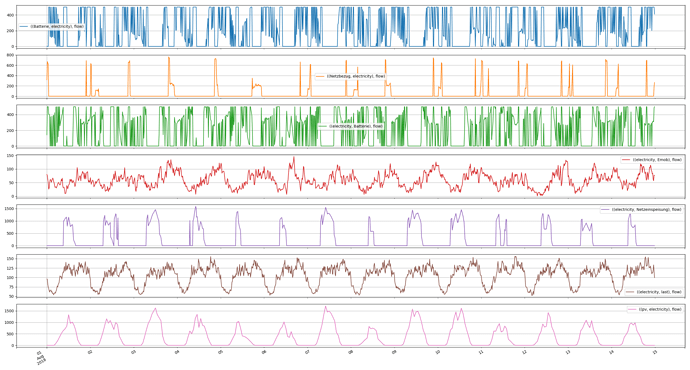Hello :),
I have some problems in my first test with oemof .
My enrgysystem has PV, demand, battery and a grid connection (sink and demand).
When the battery is not fully charged and there is more PV energy then load/demand, the battery should charge but sometimes oemof decide to use the grid connection instead of the battery.
program file:
Elektrischen Bus initialisieren
bel = solph.Bus(label=“electricity”)
energysystem.add(bel)
demands (electricity/heat)
energysystem.add(solph.Sink(label=‘last’, inputs={bel: solph.Flow(
nominal_value=1, actual_value=data[‘last’], fixed=True)}))
demands (electricity/heat)
energysystem.add(solph.Sink(label=‘Emob’, inputs={bel: solph.Flow(
nominal_value=1, actual_value=data[‘emob’], fixed=True)}))
Solareinspeisung
energysystem.add(solph.Source(label=‘pv’, outputs={bel: solph.Flow(
actual_value=data[‘pv’], nominal_value=1, fixed=True)}))
Netzüberschuss, Einspeisung
energysystem.add(solph.Sink(label=‘Netzeinspeisung’, inputs={bel: solph.Flow(
variable_costs=500)}))
Knappheitsquelle, Netzbezug
energysystem.add(solph.Source(label=‘Netzbezug’, outputs={bel: solph.Flow(
variable_costs=5)}))
Batteriespeicher
battery = solph.components.GenericStorage(label=‘Batterie’,
inputs={bel: solph.Flow(variable_costs=0)},
outputs={bel: solph.Flow(variable_costs=0)},
capacity_loss=0,
nominal_value=100,
nominal_capacity=1000,
nominal_input_capacity_ratio=1/2,
nominal_output_capacity_ratio=1/2,
inflow_conversion_factor=1,
outflow_conversion_factor=1)
energysystem.add(battery)
can someone help me?
Björn

